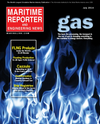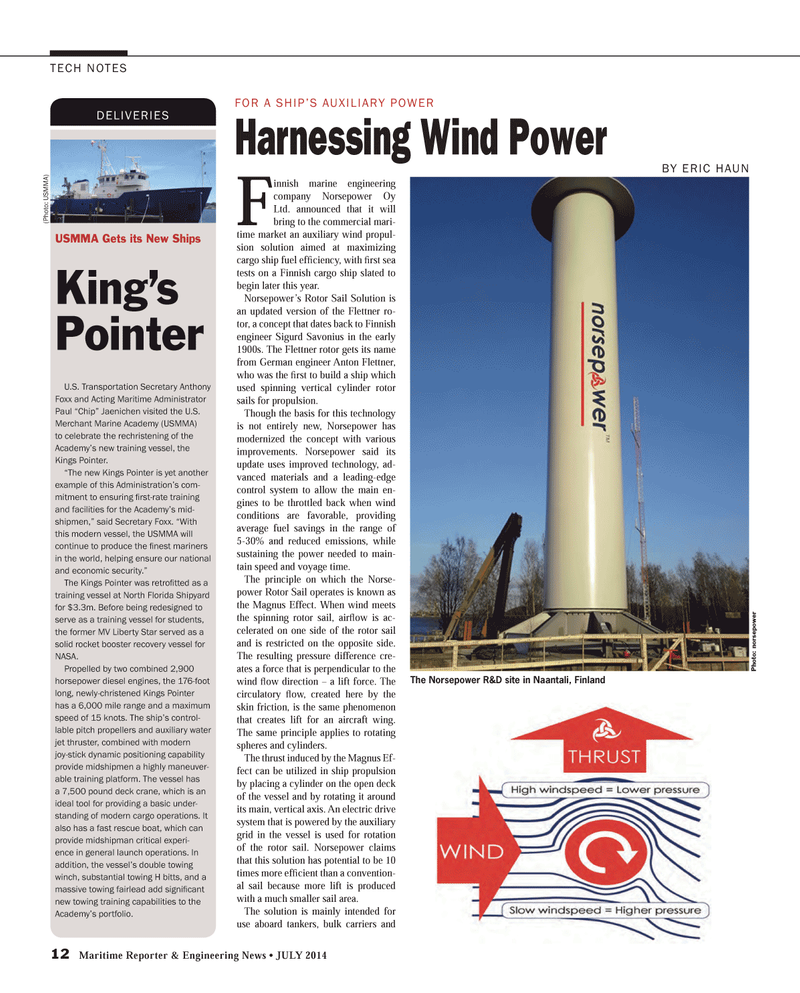
Page 12: of Maritime Reporter Magazine (July 2014)
Offshore Energy Structures & Systems
Read this page in Pdf, Flash or Html5 edition of July 2014 Maritime Reporter Magazine
12 Maritime Reporter & Engineering News • JULY 2014
USMMA Gets its New Ships
King’s
Pointer
U.S. Transportation Secretary Anthony
Foxx and Acting Maritime Administrator
Paul “Chip” Jaenichen visited the U.S.
Merchant Marine Academy (USMMA) to celebrate the rechristening of the
Academy’s new training vessel, the
Kings Pointer. “The new Kings Pointer is yet another example of this Administration’s com- mitment to ensuring fi rst-rate training and facilities for the Academy’s mid- shipmen,” said Secretary Foxx. “With this modern vessel, the USMMA will continue to produce the fi nest mariners in the world, helping ensure our national and economic security.”
The Kings Pointer was retrofi tted as a training vessel at North Florida Shipyard for $3.3m. Before being redesigned to serve as a training vessel for students, the former MV Liberty Star served as a solid rocket booster recovery vessel for
NASA.
Propelled by two combined 2,900 horsepower diesel engines, the 176-foot long, newly-christened Kings Pointer has a 6,000 mile range and a maximum speed of 15 knots. The ship’s control- lable pitch propellers and auxiliary water jet thruster, combined with modern joy-stick dynamic positioning capability provide midshipmen a highly maneuver- able training platform. The vessel has a 7,500 pound deck crane, which is an ideal tool for providing a basic under- standing of modern cargo operations. It also has a fast rescue boat, which can provide midshipman critical experi- ence in general launch operations. In addition, the vessel’s double towing winch, substantial towing H bitts, and a massive towing fairlead add signifi cant new towing training capabilities to the
Academy’s portfolio.
DELIVERIES
TECH NOTES
F innish marine engineering company Norsepower Oy
Ltd. announced that it will bring to the commercial mari- time market an auxiliary wind propul- sion solution aimed at maximizing cargo ship fuel effi ciency, with fi rst sea tests on a Finnish cargo ship slated to begin later this year.
Norsepower’s Rotor Sail Solution is an updated version of the Flettner ro- tor, a concept that dates back to Finnish engineer Sigurd Savonius in the early 1900s. The Flettner rotor gets its name from German engineer Anton Flettner, who was the fi rst to build a ship which used spinning vertical cylinder rotor sails for propulsion.
Though the basis for this technology is not entirely new, Norsepower has modernized the concept with various improvements. Norsepower said its update uses improved technology, ad- vanced materials and a leading-edge control system to allow the main en- gines to be throttled back when wind conditions are favorable, providing average fuel savings in the range of 5-30% and reduced emissions, while sustaining the power needed to main- tain speed and voyage time.
The principle on which the Norse- power Rotor Sail operates is known as the Magnus Effect. When wind meets the spinning rotor sail, airfl ow is ac- celerated on one side of the rotor sail and is restricted on the opposite side.
The resulting pressure difference cre- ates a force that is perpendicular to the wind fl ow direction – a lift force. The circulatory fl ow, created here by the skin friction, is the same phenomenon that creates lift for an aircraft wing.
The same principle applies to rotating spheres and cylinders.
The thrust induced by the Magnus Ef- fect can be utilized in ship propulsion by placing a cylinder on the open deck of the vessel and by rotating it around its main, vertical axis. An electric drive system that is powered by the auxiliary grid in the vessel is used for rotation of the rotor sail. Norsepower claims that this solution has potential to be 10 times more effi cient than a convention- al sail because more lift is produced with a much smaller sail area.
The solution is mainly intended for use aboard tankers, bulk carriers and
Harnessing Wind Power
FOR A SHIP’S AUXILIARY POWER
Photo: norsepower
The Norsepower R&D site in Naantali, Finland (Pho t o: USMMA)
BY ERIC HAUN
MR #7 (10-17).indd 12 6/30/2014 2:09:39 PM

 11
11

 13
13
